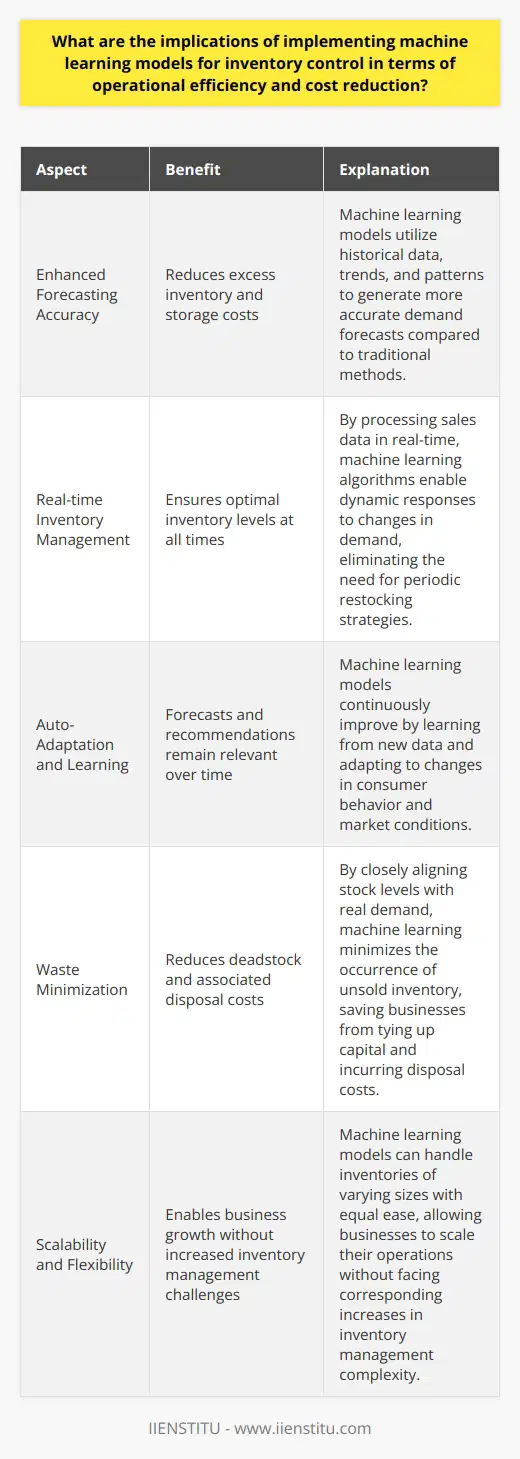
In recent years, technological advancements have significantly transformed the way companies operate, and an area ripe for innovation is inventory management. Machine learning, a subset of artificial intelligence, is at the forefront of this transformation, offering novel approaches to handling complex inventory systems.
The clairvoyance it bestows upon inventory managers allows businesses to anticipate and respond to market demands with unprecedented precision. This article probes the intersection of machine learning and inventory management, delineating why and how this cutting-edge technology is revolutionizing stock control, and ultimately, improving the overall efficacy of supply chain operations.
Understanding Inventory Management
Definition of inventory management
Inventory management is the orchestrated handling of stock and inventory to ensure that the right quantity of products is in the right place at the right time.
It is critical for maintaining the delicate balance between overstock, which could lead to increased holding costs, and understock, which can result in lost sales and customer dissatisfaction.
Importance of effective inventory management
Effective inventory management enables companies to minimize costs while boosting customer satisfaction. By efficiently overseeing stock levels, businesses can prevent revenue losses due to out-of-stock scenarios or excessive capital bound in unsold inventory.
This discipline is especially important for entities with large assortments of products or those operating in volatile markets.
Traditional methods of inventory management
Traditional inventory management often requires extensive manual effort, relying on heuristic rules and historical data for decision making.
Such approaches, while historically serviceable, are inflexible and cannot easily adapt to the rapidly changing market conditions and complex demand patterns observed in modern commerce.
Machine Learning: A Brief Overview
Definition and essence of machine learning
Machine learning is a branch of artificial intelligence that gives systems the ability to automatically learn and improve from experience. It involves algorithms that parse data, learn from that data, and then apply what they have learned to make informed decisions.
Different types of machine learning
Machine learning is broadly categorized into three types:
Supervised Learning: Where the system learns from a labeled dataset, providing answers based on the input-output mapping.
Unsupervised Learning: In this approach, the system is trained on an unlabeled dataset and is left to find structures and patterns on its own.
Reinforcement Learning: A method where an agent learns to behave in an environment by performing actions and noting the rewards or penalties.
Use cases and benefits of machine learning in various sectors
Beyond inventory management, machine learning has been successfully applied in areas such as healthcare for disease prediction, finance for fraud detection, and customer service for chatbots. The benefits include but are not limited to enhanced accuracy, process automation, and predictive capabilities.
The Role of Machine Learning in Inventory Management
Explanation of how machine learning works in inventory management
In inventory management, machine learning algorithms can analyze vast datasets to identify patterns that humans cannot.
It takes into account not only historical sales data but also other variables such as economic indicators, consumer trends, and even the weather to forecast demand more precisely.
Review of machine learning applications in inventory management
Machine learning significantly optimizes various aspects of inventory management:
Demand forecasting: Algorithmic trend analysis outperforms human foresight in predicting product demand, which is essential for inventory planning.
Production planning: Accurate demand predictions inform production schedules, ensuring that resources are allocated efficiently and without waste.
Warehousing and Distribution: Machine learning facilitates smarter warehousing solutions, optimizing everything from stock placement to the picking process, thereby reducing time and costs.
Illustration with suitable examples
A prime example of machine learning in inventory management is its ability to learn optimal stock levels across multiple locations, considering the transfer time and cost between these locations. This ensures the availability of products where and when they are needed while reducing the overall inventory holding costs.
The Benefits of Incorporating Machine Learning in Inventory Management
Enhanced forecasting accuracy
With access to complex predictive algorithms, businesses can achieve not only higher accuracy in their forecasts but also adapt to market trends more quickly, thereby staying competitive.
Improved operational efficiency
Automation of inventory-related tasks reduces the dependency on manual inputs and human errors while freeing staff to focus on more strategic responsibilities.
Reduced stock holding and shortage costs
A more nuanced understanding of demand patterns leads to the optimal stock levels, which ties up less capital in inventory and minimizes shortages that could otherwise result in missed sales opportunities.
Steps to Implementing Machine Learning in Inventory Management
Understanding the business requirements
Identifying the specific challenges and expectations of a particular business is the first step to successfully implement machine learning in inventory management.
Data collection and preparation
Machine learning models are only as good as the data they are fed. Collecting high-quality, relevant data plays a crucial role in the success of the model.
Choosing the right machine learning model
Businesses must select a model that aligns with their objectives, considering factors like the complexity of the data and the desired outcomes.
Potential pitfalls and challenges of using machine learning in inventory management
Lack of quality data
Not all companies have access to the extensive, clean data required to train effective machine learning models, which can hamper the implementation process.
Required technical expertise
Deploying machine learning solutions requires specialist skills that are currently in high demand, thus posing a challenge for many businesses.
High initial investment
Developing and introducing a machine learning-based system can be cost-prohibitive, especially for smaller enterprises that may lack the necessary capital.
Case Studies of Successful Implementation of Machine Learning in Inventory Management
Case Study 1: Retail sector (Preferred online shopping site)
An online retailer harnessed machine learning to optimize its inventory, resulting in a 10% reduction in warehouse costs and a 5% increase in customer satisfaction through improved stock availability.
Case Study 2: Manufacturing sector (Specific popular manufacturing company)
A global manufacturing firm implemented machine learning algorithms in its supply chain, enhancing its shipment forecasting accuracy by 20% and reducing rush orders by 30%.
Case Study 3: E-commerce sector (Specified online sales platform)
An e-commerce giant used predictive analytics to anticipate demand spikes, enabling it to stock products strategically and manage inventory turnover more efficiently.
Recap of the potential of machine learning in reinventing inventory management
The fusion of machine learning and inventory management presents an exciting frontier with the potential to transform how businesses approach stock control, demand forecasting, and supply chain efficiency.
Encouragement for businesses to adopt this technology and stay competitive in the market.
As industries continue to evolve and the digital marketplace expands, the adoption of machine learning in inventory management is not just a technological advancement but a strategic imperative for businesses intent on maintaining their competitive edge. As such, professionals seeking advancement in this area would benefit considerably from an online logistics certificate course or other relevant online courses with certificates that sharpen their understanding and skills in this high-demand domain.
Frequently Asked Questions
What are the implications of implementing machine learning models for inventory control in terms of operational efficiency and cost reduction?
Operational Efficiency and Machine Learning
Operational efficiency stands at the cornerstone of a competitive business. It improves service, cuts costs, and streamlines processes. Machine learning models play a pivotal role here. These models predict and manage inventory levels with unprecedented precision.
Enhanced Forecasting Accuracy
Accurate demand forecasting remains key. It avoids overstock and stockouts. Machine learning taps historical data, trends, and patterns. It yields forecasts more accurate than traditional methods. This accuracy reduces the need for excess inventory. Thus, companies save on storage costs.
Real-time Inventory Management
Real-time inventory updates become possible. Machine learning algorithms process sales as they happen. This enables a dynamic response to demand changes. It ensures optimal inventory levels at all times. Companies no longer resort to periodic, often outdated, restocking strategies.
Auto-Adaptation and Learning
Machine learning models continuously improve. They learn from new data. They adapt to changes in consumer behavior and market conditions. This ability ensures forecasts and recommendations stay relevant. Businesses benefit from a system that gets better over time.
Cost Reduction through Waste Minimization
Waste represents a substantial cost for many businesses. Deadstock, or unsold inventory, ties up capital. It also incurs disposal costs. Machine learning minimizes such wastage. It does so by closely aligning stock with real demand.
Dynamic Pricing Strategies
Machine learning facilitates dynamic pricing. It analyzes inventory levels, demand, and market trends. Thus, it can recommend pricing adjustments. These adjustments help clear excess stock or capitalize on high demand. Ultimately, businesses maintain more consistent profitability.
Lean Inventory and Just-in-Time Practices
Just-in-Time (JIT) practices reduce inventory costs. They involve maintaining only necessary stock levels. Machine learning makes such practices more feasible. It does so through its predictive capabilities. Businesses can trust they will not run out of stock unexpectedly.
Reduction in Manual Tasks
Automation in inventory control reduces manual labor. It saves employees' time for more strategic tasks. Machine learning automates ordering, forecasting, and restocking. This shift cuts labor hours and associated costs.
Scalability and Flexibility
Machine learning models scale with the business. They can handle small or vast inventories with equal ease. This scalability means that businesses can grow without a corresponding increase in inventory management challenges.
Challenges to Consider
However, one must not overlook possible challenges. Implementation demands a sizable initial investment. Not all businesses can afford this. They need skilled personnel to develop and maintain machine learning systems. Dependence on technology creates vulnerabilities as well. Systems can fail or face cyber threats.
Implementing machine learning for inventory control holds considerable promise. It boosts operational efficiency and fosters cost reduction. It demands consideration of its challenges as well. Nevertheless, the competitive advantage it offers makes it a crucial consideration for any forward-thinking business.

How does machine learning contribute to accuracy and predictability in inventory control, and how can this impact demand planning?
Machine Learning in Inventory Control
Inventory control stands as a pivotal element in supply chain management. It balances stock levels, preventing excessive or insufficient inventories. Machine learning plays a crucial role here. It enhances accuracy and predictability.
Enhanced Forecasting Accuracy
Machine learning algorithms excel in pattern recognition. They analyze historical data extensively. This includes sales, seasonal trends, and market shifts. These algorithms predict future demands with high precision. Better forecasts lead to optimized inventory levels.
Real-Time Data Processing
Machine learning thrives on real-time data analysis. It gathers insights from ongoing sales activities. This leads to proactive inventory decisions. Real-time adjustments prevent overstocking and understocking. They ensure retailers respond swiftly to demand changes.
Predictive Analytics for Demand Planning
Demand planning is the strategy's core. Machine learning facilitates predictive analytics here. It anticipates customer behaviors and product trends. Accurate predictions ensure adequate stock levels. They align inventory with anticipated market needs.
Automated Replenishment
Machine learning enables automated inventory replenishment systems. These systems analyze sales speed and stock levels continuously. They trigger restocking processes autonomously. This ensures consistent availability of products. Automation reduces human errors. It frees staff for other strategic tasks.
Adaptive Learning for Improved Predictability
Machine learning models adapt over time. They learn from new data and outcomes. This adaptive learning improves predictability in inventory control. It refines forecasting models with fresh insights. Adaptability is key to tackling the dynamic nature of demand.
Reducing Stockouts and Overstocks
Accurate machine learning forecasts reduce stockouts. They also prevent overstocks. Both consequences are expensive. Stockouts lead to lost sales. Overstocks occupy space and tie up capital. Machine learning minimizes these risks. It does so by maintaining optimal inventory levels.
Enhanced Supply Chain Coordination
Machine learning improves coordination across the supply chain. It provides stakeholders with predictive insights. This enhances collaboration between manufacturers, distributors, and retailers. Better coordination ensures responsive supply chains. It allows for quick adaptation to demand changes.
Machine learning revolutionizes inventory control. It does so by boosting accuracy and predictability in demand planning. Retailers enjoy optimized stock levels and improved supply chain coordination. This leads to significant cost savings and increased customer satisfaction. The impact of machine learning is profound. It will continue to shape the future of inventory management.

What challenges might be encountered when harnessing machine learning technologies for inventory management and how can they be effectively addressed?
Challenges in Machine Learning for Inventory Management
Machine learning (ML) has profound potential to transform inventory management. Yet, adopting ML technologies presents significant challenges. These include data quality issues, system integration complexity, and the risk of over-reliance on technology. Moreover, the required investment and the need for skilled personnel pose additional difficulties.
Data Quality and Quantity Concerns
Quality and quantity of data are crucial for ML success. ML algorithms need vast amounts of accurate, clean data to train on.
Data Cleansing: Ensuring data integrity can be laborious.
Data Collection: Gathering vast datasets demands resources.
Historical Data: Lack of relevant past data can hinder forecasting.
By implementing data governance frameworks, organizations can improve data quality. Regular audits and cleansing protocols are key. Also, investing in data collection infrastructure is vital.
System Integration and Infrastructure Hurdles
Integration of ML with existing systems can be daunting. Legacy systems are often incompatible with modern ML solutions.
Compatibility Issues: Existing IT systems may resist smooth integration.
Real-Time Data: ML relies on up-to-date information for accurate predictions.
Infrastructure Costs: Advanced ML applications require robust computational resources.
Building adaptable APIs aids integration. Emphasizing real-time data capture infrastructure can ensure the flow of current information. Additionally, initial expenses in ML infrastructure are a long-term investment.
Over-Reliance on Machine Learning
The allure of ML can lead to over-dependence.
Human Oversight: Human judgment remains critical.
Algorithmic Transparency: Understanding how algorithms make decisions is essential.
Continuous Evaluation: ML models require regular performance checks.
Balancing automation with human expertise curbs over-reliance. It is crucial to maintain a level of transparency in ML operations. Teams must review and update ML models consistently.
Investment and Cost Considerations
The cost of ML adoption can be prohibitive.
High Initial Investment: ML technologies often demand significant startup capital.
Return on Investment: Assessing long-term benefits against initial costs is complex.
Ongoing Maintenance: ML systems require continuous upkeep and improvement.
Careful financial planning can mitigate investment risks. Calculating potential ROI helps justify the outlay. Planning for ongoing maintenance costs ensures system longevity.
Talent and Expertise Demands
Skilled personnel are necessary for ML initiatives.
Expertise Shortage: There is a global scarcity of ML talent.
Training: Existing staff may require upskilling.
Recruitment: Attracting the right talent can be competitive.
Investment in training and personal development is essential. Crafting compelling roles and career paths attracts ML talent.
Effectively Addressing Machine Learning Challenges
Addressing these challenges requires a measured approach. Embracing an evolutionary path towards ML application stabilizes the transition. Ensuring sound data practices, investing in integration technologies, and maintaining a balance between human and machine intelligence are imperative.
Financial considerations should include meticulous planning and ROI calculations. Lastly, nurturing a culture of continuous learning and talent development is central to overcoming ML implementation obstacles in inventory management.



